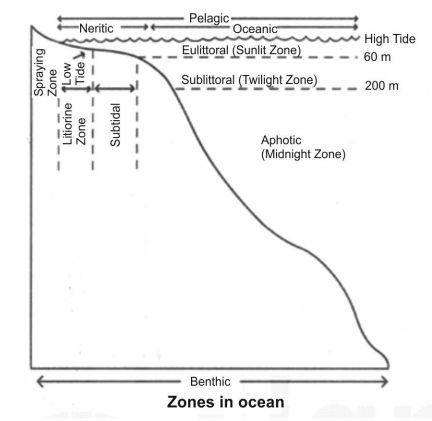Terrestrial-and-aquatic-ecosystems / Terrestrial and Aquatic Ecosystems / Marine Ecosystems
• The oceans constitute nearly 71% of the earth’s surface and as a habitat provide an unusual stability in temperature, salinity and gaseous contents.
Classification of Marine Ecosystem
- Two major divisions of the ocean are recognized. They are the pelagic and the benthic zones or regions. The pelagic region includes the sunlit surface waters while the benthic zone includes the ocean floor.
- Pelagic region:
- The pelagic area of the sea can be distinguished into, the neritic province and the oceanic province.
- The neritic province consists of water up to a depth of 200 meters and it is close to the land mass. It is considerably influenced by the facts of terrestrial environment.
- The oceanic province extends from the continental shelf to the archibenthic (about 1,100 meters) level. This oceanic province is free from the influences of terrestrial environment.
- The flittering surface waters of the ocean are known for their teeming abundance of living organisms. The most characteristic feature of all pelagic animals (animals which live at the surface) is their ability to keep themselves afloat.
- Benthic region:
- The benthic biotic environment is concerned with ocean floor and forms two main zones
- The lighted zone of littoral benthal which is more briefly referred to as littoral zone and
- The lightless archibenthal or abyssal benthal forming the so-called deep sea systems.
- The line of demarcation has been fixed at 200 meters depth, to which light usually penetrates.
- The littoral zone extends from the high tide level to about 250 miles off the shore and roughly to about 200 meters depth up to the edge of continental shelf).
- This archibenthal zone extends from 200 meters to 1,000 meters depth. The abyssal zone covers the ocean bottom running upto 6,000 meters.
- From 6,000 to 10,000 meters the region is generally referred to as “Ocean-deeps”.
- The littoral zone is further subdivided into two divisions
- The eulittoral zone extends up to 40 to 60 meters and is known for its luxuriant vegetation.
- The sublittoral zone extends from this point to about 200 meters depth.
- Eulittoral zone:
- It includes the well known intertidal zone which is bound by high and low tide marks. Though the tidal zone is rather well defined, its vertical range varies in different parts of the world for it is dependent on the tidal range.
- The eulittoral zone gives rise to many biotopes dependent on the substrata such as the rocky, sandy and muddy zones. Unlike the open oceans which are known for the constancy of conditions, the eulittoral zone is known for its diversity of the physico-chemical conditions of the habitat.
- The marine eulittoral zone biologically as well as ecologically can be divided into four main zones, viz. (i) Spraying zone (ii) Littorine zone (iii) Balanoid zone and (iv) Subtidal zone.
- The spraying zone occurs nearer to the land mass and the animals living in this zone are exposed to the spray caused by the dashing of the tireless waves. This is the rocky part of the eulittoral zone. Only forms like isopods which can withstand adverse conditions are present in this zone.
- The Iittorine zone is the true intertidal zone and exposed either for long or short periods due to the ebbing of tides. This zone is characteristic of the sandy and muddy shores of the eulittoral zone.
- The balanoid zone is seen in rocky coast margins and are absent in the muddy and sandy shores. This zone is dominated by the barnacles and hence the name balanoid zone.
- The subtidal zone is clearly demarcated in the rocky coast margins, wherein are found the rocky pools. The animals living in rockpools are seldom exposed to the severity of atmospheric conditions. The temperature of the water is always greater than the sea. This zone is particularly noted for its richness of fauna e.g. Sea-anemones, fishes, polychaets and extension of coral reefs.
- Sub-littoral zone:
- It extends from the low water tide mark to about 200 meters.
- It is of a soft consistency and is largely composed of sand, mud and clay in which a large number of benthic organisms (e.g. molluscan shells) are found.
- Plentiful supply of food and oxygen and the optimum conditions of temperature are responsible for the richness of the sublittoral fauna upto 100 to 120 meters wherein plant life exists that are chiefly calcareous seaweeds.
- The coral reefs form a distinct biotope in the sub littoral zone. The bottom fauna includes variety of sponges, foraminiferans, crustaceans, worms, star fishes, sea-urchins, seacucumbers, brittle stars, seafans, sea-pens, lobsters, crabs, mollusks and fishes.


